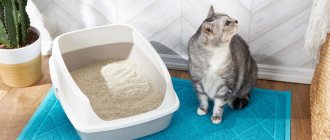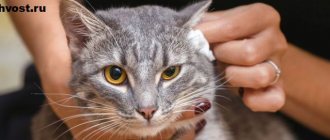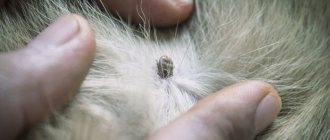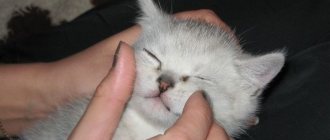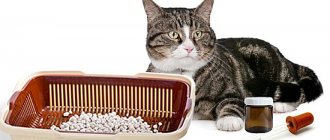Compliance with the rules of pet hygiene is the key to its health. Despite the fact that cats are one of the cleanest animals, it is necessary to carry out water procedures periodically.
It is most important to wash your cat if it has access to the outdoors. During a walk, the fur collects dust, in addition, the pet can become infected with something through spoiled food, dirt and contact with other animals.
Do cats need to be bathed at all?
Of course, the benefits of bathing are obvious. After all, hygiene is one of the important components of cat health. But, on the other hand, cats are already, by nature, very clean people. Some lick their fur for days on end and do it so thoroughly that one can only envy their patience. Moreover, it doesn’t matter whether she is at home or prefers to spend most of her time outside.
A cat can lick itself for hours
Many cat owners believe that bathing is not necessary. After all, cats used to get along just fine without it. They ate the mice and licked the dirt from their paws, and no sore affected them. Yes, of course, when our grandmothers and great-grandmothers lived, cats were not looked after like that. But we should not forget that times change, and with them the environment. And if earlier there were noticeably fewer bacteria and viruses, now their number and varieties are simply frightening.
Therefore, the answer to the question of whether cats need to be bathed is unequivocal - it is necessary. Your pet still won’t be able to deal with dirt the way a caring shampoo can.
Important! Tails who constantly live at home need to be bathed less often than those who walk outside.
So that after washing procedures you (and your neighbors) do not become deaf from loud meowing and leave the bath as if you were attacked by 20 angry cats, and your pet does not take offense at the whole world and does not tremble like an aspen leaf, it is not enough to buy shampoo. You need to know how to perform the manipulation correctly. After all, this is real stress for a cat.
Cat's reaction to bathing
Veterinarians recommend not to refuse manipulation, even if your pet is aggressive towards water. This is especially true for long-haired breeds (Persians, Maine Coons), which will not be able to manage their hair on their own. That’s why they often form tangles, which don’t look at all aesthetically pleasing. You should definitely bathe your animal if there are fleas and other ectoparasites on its body - ticks, lice, lice. Moreover, the procedure in this case must be carried out as often as possible, otherwise it risks dangerous infections.
In addition, veterinarians recommend bathing a cat if its skin is too sensitive and prone to rashes and dermatitis. In this situation, you should use medicinal products.
What are the benefits of bathing for four-legged furries?
- prevents skin dryness and flaking;
- accelerates the shedding process, helping to remove dead hairs;
- the coat renews itself and grows faster
- reduces the amount of wool on the floor in the apartment, on clothes, furniture;
- prevents the appearance of tangles, the fur coat will have a more well-groomed appearance;
- allows you to fight parasites and fungi.
Getting rid of tangles
How to train for the first time
The attitude of cats to bathing is an individual matter, but most pets are afraid of water and try to avoid washing. It is important to immediately let the pet know that the owner will not offend you and only wants the best. You need to earn the trust of your four-legged friend, so they act softly, gently, but confidently. Kittens are easier to teach such procedures, but adult cats can also be well introduced to bathing.
If a cat has never been washed before, its first impression of this procedure is very important, since its perception and further attitude towards washing is formed. Under no circumstances should you put moral pressure on your pet; he may already be scared.
Before washing, it is advisable to assess the condition and mood of the cat. If the pet is awake and feeling well, it is useful to play with the cat so that it gets a little tired and relaxes. After this, they carry out all the necessary preparations for bathing, wash the pet and then praise it and reward it with goodies.
If the cat is too afraid, you need to calm her down and reschedule the procedure for later. However, it is worth remembering that cats are highly intelligent animals and can be cunning to avoid bathing. You need to understand the line where the cat is really afraid and requires moral support and where she is playing around.
Parenting should be motivating and goal-oriented. In this case, the desired result can be achieved quite quickly.
What you need to bathe a cat
There is no need to immediately throw the cat into a filled bath. Then you run the risk of seeing a cat flying all over the bathroom. Jokes aside, the procedure requires careful preparation. For swimming you need the following items:
- Shampoo. There are many types of detergents for cats. They can be intended for various purposes - treatment, removal of ectoparasites, fur care, etc.
- Latch. A very convenient thing that prevents the cat from jumping out of the bath. Presented in the form of a collar, to which a rope with a suction cup is sewn. It is attached to the bathroom. An excellent option for those who are not eager to run around the entire apartment after a soapy cat.
Retainer
- A washcloth in the form of a mitten. The cat can also be washed by hand. However, for pets with long hair and the presence of parasites, a manual procedure will be useless. In this case, it is better to use a massage mitten. It will protect you from possible scratches and distribute the detergent well over the four-legged fur. A special brush for washing cats is suitable for the same purposes.
Massage brush for bathing and combing
- A large towel (or better yet, two). The first towel is used as a base towel to absorb moisture from the fur, and the second is used to wrap the cat to prevent freezing. This way, the cat’s thermoregulation will quickly recover.
After bathing, wrap the cat in a towel
- Cotton balls. It is imperative to insert it into your pet’s ears to prevent water from penetrating into the ear canals. Today, pet stores sell special caps and head covers that prevent fluid from entering the ears.
Cat in a bathing cap
You can bathe your pet either in a bathtub or in a basin. The last option is more preferable. It will be easier to keep the cat in such a container.
How often should the procedure be performed?
It is best to carry out the procedure in the summer, when the animal’s fur undergoes shedding. It is known that at this time the cat licks itself much more intensely, which can lead to hair getting into its stomach and subsequent vomiting. To avoid this, veterinarians recommend bathing the animal during periods of intense shedding 2-3 times a month so that the hairs can be removed more easily.
Otherwise, one bath once every 2 months is enough if the cat walks outside. If the cat stays at home, then you can get by with 1 procedure every 3 months. There is no need to bathe the animal more often. Otherwise, there is a possibility of washing off the protective layer from the skin, which will lead to a decrease in local immunity. Then the purr will be more likely to be susceptible to skin infections and dermatitis.
The bathing schedule directly depends on the breed and length of the coat, as well as the conditions of detention. So, hairless cats - bambino, lykoi, sphinxes should take water procedures more often. Their sebaceous glands work more intensely, fat accumulates on the surface faster, which leads to an unpleasant odor.
Bathing a Sphynx cat
Cats with long hair - Maine Coons, Persians, as well as Siberian, Bengal and Abyssinian breeds - also bathe more often than others.
Important! During the molting period, you should not bathe Siamese, Ural Rex, or Oriental cats. Water procedures can lead to bald spots on the body of cats, since they shed very much.
Certain circumstances can disrupt your bathing schedule. This includes heavy contamination with chemicals or dirt, participation in exhibitions and other demonstration events.
What you need and what you don’t need to do while bathing
Before the procedure, veterinarians recommend thoroughly combing the cat and removing tangles. Then insert cotton balls into your pet's ears or put a special cap on his head. After this, the massage mitten is moistened in water, and a detergent is applied to its surface. After foaming, the shampoo is gently rubbed into the animal’s fur with massage movements. There is no need to press hard, otherwise it will scare the animal even more, and then it will be much more difficult to restrain it.
Bathing a cat in a basin
If you are planning to bathe your cat in a basin, then place it in the bathtub. It is better to line the bottom of the basin with a terry towel or rug so that the cat does not slip. The room in which bathing takes place must be cleared of foreign objects, otherwise they risk ending up in the bathtub (basin) or, worse, on the cat’s head.
Water is also important when bathing an animal. Its temperature should not exceed 40°C and be at least 36°C. Veterinarians pay attention to the proper water level. It should not be higher than the level of the pet's stomach. Therefore, there is no need to fill the bathtub (basin) to the top. If the cat does not feel the bottom under his paws, this can greatly frighten him.
Thermometer for measuring water temperature (without mercury)
Be sure to trim the animal’s claws before the procedure. It is very important. This way you will protect yourself from possible scratches and damage.
Attention! The cat is afraid not so much of the water itself, but of its noise. Therefore, it is better not to turn on the water in front of your pet, but to fill the bath in advance. The shampoo should be washed off under a thin stream of shower or by hand.
There should be no loud sounds, screams, or pressure. Try to be calm and affectionate.
It is more convenient to bathe a cat together. Immediately assign roles - who will hold the animal and who will bathe it. It is better to entrust the bathing process to the person the cat loves most.
Important! Purrs should not wash their noses and ears. This can lead to inflammatory reactions and infection. If a lot of sulfur has accumulated in the hearing organs, and cloudy liquid flows out of the eyes, it is better to use special preparations. We have already written about how to wash a kitten’s eyes. Saline solution is suitable for the same purposes.
Video - Bathing a cat in the bath
Expert advice
Veterinarians and professional groomers advise you to be careful when choosing cosmetics for your cat, and also to bathe in accordance with the general rules. You need to pay attention to the character and mood of your pet, find an individual approach to each pet.
You shouldn't bathe cats too often, but you shouldn't let them get dirty either. It is helpful to create a bathing schedule and stick to it, making adjustments as necessary. If you identify warning signs during bathing (skin problems, parasites), you should not delay visiting the veterinarian and consult with a specialist as soon as possible in order to provide your pet with the necessary help in a timely manner.
The bathing process itself
When all the preparatory steps have been completed, the water has been collected, the most crucial moment comes - immersing the cat in the water. You shouldn’t squeeze the cat’s paws with all your might, fuss, or scream. All this can greatly frighten the purr. And the likelihood that you will be scratched, your cat will escape and hide under the bathtub will increase exponentially. Therefore, try to be gentle and calm.
But you shouldn’t do this to a cat!
Immerse him in water gradually, starting with his hind legs. If the cat is stubbornly resisting, and you started the procedure alone, call a second person for help. When all four paws are in the water, you can actually start swimming. Don’t forget to close the door to the bathroom, otherwise the soapy cat will escape and run around the apartment, which will add extra work to you.
Here is the algorithm of actions:
- Scoop up water with a ladle and start watering your pet in a small stream.
- It’s better to start from the buttocks and back area. This way the cat will quickly get used to the water, sounds and sensations.
- Gradually move towards your head. It is better to wet the fur near the ears and eyes by hand so as not to frighten the animal.
- When the cat's fur is completely wet, you can apply the shampoo using a foamy washcloth or your hands (avoid getting the product in the ears and eyes!).
- According to the instructions, leave the shampoo on the animal's body for a while. There is no need to soap your face. The pet does a good job of cleaning it himself.
- Carefully, also using a ladle or a thin stream from the shower, rinse off the shampoo (from top to bottom).
Rinsing off shampoo with a gentle stream from the shower
Attention! The shampoo must be washed off thoroughly, otherwise its particles may remain on the animal’s skin and cause the development of allergic reactions. In addition, the product can enter the cat’s stomach when licked, which will lead to poisoning.
At the end of the procedure, carefully remove the cat from the basin and blot its fur with a towel. Then wrap it up and, if necessary, dry it with a hairdryer. The cat must be protected from drafts and cold.
Drying the fur after bathing
Attention! If you plan to castrate a cat, then it is better to bathe it before the operation, since you cannot wash the suture to avoid infection - only treat it with antiseptic drugs.
Drying the cat with a second towel
Take care of your personal safety. If you are afraid of getting scratched, it is better to arm yourself with thick or winter gloves. Clothes should also be thick (which you don’t mind throwing away later). I'm not kidding! There are plenty of stories in medical practice that indicate serious damage after bathing cats.
How to wash your eyes and ears
- Soak a cotton pad in warm water and wipe your pet's eyes with light movements.
- Wipe the outer part of the ear with a cotton swab dipped in a drop of Vaseline oil.
- Do not wash your cat's ears with water or other liquids.
Expert opinion
Dusheba Vera Ivanovna
In 2010, she graduated from the Moscow State Academy of Veterinary Medicine named after K.I. Scriabin with honors, specializing in veterinary medicine. I regularly attend veterinary conferences, congresses, and webinars.
The cat's fur creates an ideal air cushion that retains heat and provides the cat with maximum comfort. When the fur gets wet, this comfort evaporates - after bathing, it is important to wrap your pet in something warm and take it to a draft-free bedroom.
It is advisable to have someone help you when bathing - the cat will resist. You can hold the cat while another person washes him and sprays him with a watering can to rinse off the shampoo.
How to bathe a kitten
To prevent the kitten from remembering the bathing procedure as something frightening, you should accustom it to water gradually. Try to get him to go into the bathroom more often and hear the sounds of running water. It is recommended to start by washing your paws. If the baby resists, do not insist.
Bathing a kitten
Take him in your arms and show him a trickle of water. Perhaps he himself will want to play with a new fun “toy”.
Attention! Bathing should begin at 4 months of age.
First bath
Since small fidgets get dirty more often than adult cats, you need to bathe him as he gets dirty (if he went to the toilet carelessly, got dirty, or there are fleas and ticks). It is not recommended to carry out the procedure too often unnecessarily, so as not to wash off the protective layer from the skin.
Important! If the kitten is very afraid of water, then you can buy dry shampoo in the store. This is a good alternative to the usual product. It is a dry powder resembling powder. The shampoo is rubbed into the fur, then small particles are removed using a combing brush.
Veterinarians recommend bathing a kitten 3-4 hours after eating. To make bathing take place in a more favorable environment, take your baby’s favorite toy into the bath or move a string in front of his face to let him know that the procedure is absolutely safe and there is no reason to worry. It would be nice to praise the kitten after bathing and give him his favorite treat.
Attention! To prevent the process from frightening your baby, start taking water procedures in a place that is less frightening for him, that is, in the room where he likes to play.
How to wash a cat if he is afraid of water
A kitten accustomed to water from birth will not be afraid of bathing. However, if an adult cat bathes for the first time, fear is inevitable. Stroke the distressed animal, gradually accustom it to water: first wet its belly, then one paw, then the other.
If the cat is very hysterical and his heart is pounding, it is better to postpone the procedure. Remove the animal from the bath, wrap it in a blanket and let it calm down.
The best time to wash your cat is when he is relaxed. Before the procedure, you can play with it and stroke it. When bathing, he will struggle - this is obvious, you should not scream and swear, as this will increase the pet’s stress level. If you can’t wash your cat the traditional way, use dry shampoo - it cleans just as well as regular shampoo.
Is it possible to bathe a pregnant cat?
Pregnant cat
Veterinarians strongly recommend not to do this in the last stages of pregnancy. At the beginning, water procedures can be carried out, but only if the cat was normal about it before. If before pregnancy the bathing process led to real stress or became a test for the animal, then it is better to wait until after delivery.
Precautionary measures
There are cases when a cat was healthy for many years, its fur looked shiny, and suddenly it began to deteriorate: it became dull, matted, dandruff appeared, and an odor appeared. The first thing the owner hurries to do is bathe the pet. After the bath, the condition of the coat improves, but not for long. It is important to know that a sharp deterioration of the coat indicates an emerging disease or malnutrition. In this case, the best option is to consult a veterinarian for help.
To bathe or not to bathe a cat is a controversial topic. Some are for swimming, some are against. It is better to approach the issue from a position of common sense. If the animal is clean and smells good, there is no point in subjecting it to unnecessary stress. In other cases, carefully choose a shampoo and carry out the washing procedure as gently as possible for your furry friend.
Is it possible to dry fur with a hairdryer?
Blow-drying is another procedure that can cause stress in your cat. Imagine, when a pet has just moved away from water procedures, he immediately has to overcome a new obstacle. Therefore, if it is possible to do without blow-drying, then it is better not to do so. It’s another matter if the house is cold, it’s winter outside, and the cat has very thin, sparse fur.
Drying cat hair using a hair dryer
Drying the animal after washing
At the end of the procedure, be sure to dry the animal. Drain the water from the bath and cover the cat with the first towel, lightly blot the fur with it. Do not rub to dry it as quickly as possible - this will tangle the hairs.
Take a clean, large towel and wrap your cat in it, holding him close to you to show you care - you can whisper something soothing in his ear. She may start shaking violently, but after a couple of minutes it will go away and she will calm down.
Try drying the animal with a hairdryer. Have a helper play it in another room so your cat gets used to the sound. Holding it securely in your hands, gradually approach the hair dryer, open its muzzle and direct a warm stream of air at it. If your pet reacts more or less calmly, continue to remove the towel in parts and dry it with a hairdryer. In the future, the cat will understand that the heat source comes from this noisy unit, and will treat it more calmly.
If the cat is frightened by the hair dryer and tries to break free and run away, leave this idea. Release the cat so that it can dry naturally. Make sure that there are no drafts in the room, otherwise your pet may catch a cold - after all, she has become more vulnerable without her air cushion under her fur. Most often, kittens and older cats are susceptible to colds because they do not regulate their body temperature well.
If there are no radiators in the house, turn on the heater for your pet and let her dry near it. After water treatments, the cat will lick its coat for a long time, and there is no need to interfere with it.
Is it possible to bathe a cat with shampoos intended for humans?
Many owners prefer not to spend money and use their own shampoos to wash their cats. We hasten to disappoint such brave souls. Human washing products are absolutely not suitable for animals. The main reason is a different water-alkaline balance, the likelihood of developing an allergic reaction and deterioration of the cat’s skin condition.
Important! A person's skin pH is 5.5, while a cat's pH is 7.5. That's why more alkali is added to human shampoos. What happens if you wash a cat with human hair wash? It will have an aggressive effect on the pet’s skin, which means the animal will itch a lot. And inflicted injuries and abrasions are an excellent conductor for bacteria, fungi and microbes.
Washing cats with soap and “human” shampoo is not recommended.
The same goes for soap. Veterinarians are skeptical about this remedy. When used in cats:
- the protective layer is washed off from the skin, which leads to loss of local immunity;
- the skin becomes dry and dehydrated;
- the coat ceases to shine and becomes stiff;
- allergies may appear;
- dandruff occurs.
Therefore, you should not save on your furry pet, so as not to spend even more money on its treatment later. It is better to go to a pet store and find a suitable animal wash.
Which shampoo to choose?
The question of what to lather the fur with: regular shampoo or choose a special product for washing your cat at home is controversial. Artificially bred breeds have thin and delicate skin, often susceptible to allergies. Aggressive shampoo intended for humans, and even more so soap, can cause great harm. For example, cause eczema, dandruff, dryness and cracked skin.
To bathe a British or Scottish cat, you will have to pick up a special cleaning product from a veterinarian that will eliminate the unpleasant odor and add shine to the coat.
For babies, it is better to buy products for kittens that protect delicate skin from damage and do not irritate the mucous membranes. Old cats should be washed with hypoallergenic products that eliminate itching and flaking.
© shutterstock
Washing with baby shampoo is undesirable even for domestic felines. But in rare cases, this rule can be neglected if nothing else is at hand.
Bathing products
Shampoos for cats are produced in powder (dry), spray and liquid (gel) form. The most popular is the last one. However, they are often not allowed to be used, otherwise the protective layer can be washed off from the skin.
Using dry shampoo to wash an adult cat
Dry shampoos are considered the best option if the animal completely refuses water treatments. All you need to do is apply the product to the coat and then comb it with a brush. In addition, it is preferable to use this type of shampoo in the cold season, when there is a chance that your pet will catch a cold after bathing.
Dry shampoo for cats
Sprays are a waterless product that is most often used for pets with long hair. This option is good in its own way. However, not all animals can withstand the notorious “zilch.” Therefore, it is better not to use this remedy for cats with weak nervous systems.
Spray for washing cats
Detergents for cats
Conventionally, all cat shampoos can be divided into four types:
- Cosmetic , which are suitable for washing away dirt from the fur of a four-legged animal and improving the quality of the fur coat. Every cat owner should have this shampoo, and this is what you should use for regular washing of your pet.
- Specialized ones that are used before demonstration events. For example, shampoos for removing mats, cosmetics for dry or oily hair. Anti-matt cosmetics work on the following principle: wool particles have a negative charge, and the molecules of the product have a positive charge. Accordingly, after using this shampoo, the hairs are smoothed out, and the coat after bathing becomes smooth, manageable and easy to comb. Shampoos for dry hair contain substances that retain moisture in the hair follicles and protect them from the negative effects of sunlight. Shampoos for oily coats slow down the process of oil production and restore the functioning of the sebaceous glands.
- Medicinal , for example, antipruritic, used for allergies, or antibacterial. Note that allergy shampoo does not cure the disease itself, but only reduces the intensity of the symptoms - itching, pain, burning. Antibacterial shampoos include an antiseptic element that calms the inflammatory process and eliminates the accompanying symptoms.
- Antiparasitic, eliminating fleas and ticks. A good quality shampoo can rid an animal of fleas after the first use. You must act strictly according to the instructions, after consulting with your veterinarian about a specific drug. Please note that anti-flea shampoos cannot be used as detergents, only to rid the cat of parasites.
Attention! If you plan to wash your cat with shampoo and conditioner, then it is preferable to choose products from the same brand.
Table 1. Shampoos for cats.
| Name | Variety | Purpose | Volume, ml | price, rub. |
| Chris Christensen Jungle Apple with apple flavor (concentrate 1:50) | Cosmetic | Designed for deep cleaning of wool | 355 | 930 |
| Shampoo Trixie Trocken | Cosmetic | Gentle grooming | 250 | 265 |
| Gentle | Cosmetic | To wash away dirt from fur | 180 | 90 |
| Perfect Coat Shed Control & Hairball | Specialized | Anti-shedding and anti-matting with tropical scent | 295 | 320 |
| ProVitamin Shampoo Anti Tangle | Specialized | From tangles. Provitamin shampoo is specially created for gentle care of cats with long hair. | 295 | 425 |
| Elite Professional | Specialized | For long-haired breeds. Recommended for sensitive skin. | 270 | 509 |
| Biovax | Specialized | For oily coats | 305 | 109 |
| Jerob | Specialized | Basic shampoo for preparing an animal for a show | 237 | 1300 |
| Dr. Goodman | Medicinal | For animals with problem skin | 250 | 267 |
| Animal Play Tar universal | Medicinal | The composition contains birch tar. Has antimicrobial, antifungal, antiparasitic and anti-inflammatory effects | 250 | 139 |
| Biovax for oily wool | Medicinal | For allergies and itching – a cosmetic and hygienic product for the care of the skin and fur of animals prone to allergies | 200 | 290 |
| GAMMA | Antiparasitic | For cats and kittens, antiparasitic with herbal extract | 250 | 90 |
| Lugovoy | Antiparasitic | It is an effective contact insecticidal agent. Destroys fleas, lice and hair lice (hairworms) that parasitize cats | 270 | 154 |



